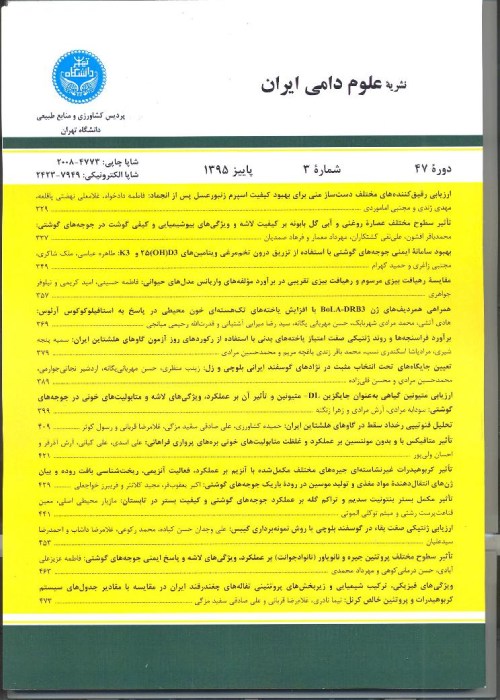Evaluation of probiotic potential of lactic acid bacteria isolated from bee gastrointestinal tract and their effect on some productive parameters of colonies
Author(s):
Article Type:
Research/Original Article (دارای رتبه معتبر)
Abstract:
This study aimed to isolate lactic acid bacteria from gastrointestinal tract of honey bees (Apis mellifera) and assess the probiotic potential of isolates, and their effect on some performance parameters of colonies. Thus, 10 colonies out of an apiary with one hundred bee colonies were randomly selected and used for sampling. Twenty worker bees were sampled from each hive and after being transferred to the laboratory under complete comfort and ventilation conditions, their gastrointestinal tract was completely isolated under carbon dioxide flushing, and after culture in MRS medium different microbial colonies were selected. Liquid-solid periodic cultures were repeated up to 8 steps to achieve pure cultures. Finally, gram-positive, catalase and hemolysis negative samples were isolated and identified based on phylogenetic analysis. The results of identification of the isolated bacteria using 16s rRNA sequences showed that G1 isolate (MA4 strain) was 99% similar to Pediococcus acidilactica, the G2 isolate could not be sequenced due to technical problems in sending samples abroad and isolate G3 (strain MA5) was 99% similar to lactic acid pediococcus strain 8185. Finally, the strain MA14 isolated from the bee's gastrointestinal tract during the summer under anaerobic conditions was 97% similar to the HM75-1 strain Pediacocus pentosus, which was named G4. These bacteria were registered in the Gene bank (NCBI) with accession number of MW376601, MW376904, MW376896 and MW405566, respectively. In vivo studies showed the positive effects of treatment with isolates by spraying on frames and bacterial culture mixed in syrup (sugar-water) on spawning, production and hygienic behavior of bees. Comparison of treatments with Duncan's multiple range test (p≤ 5%) showed that all experimental treatments in quantitative population factors and spawning and quality were significantly different from the control treatment. However, the control treatment had a significant difference in honey reserves due to low spawning compared to experimental treatments and less nectar consumption.
Keywords:
Language:
Persian
Published:
Iranian Journal of Animal Science, Volume:53 Issue: 2, 2022
Pages:
97 to 107
magiran.com/p2487759
دانلود و مطالعه متن این مقاله با یکی از روشهای زیر امکان پذیر است:
اشتراک شخصی
با عضویت و پرداخت آنلاین حق اشتراک یکساله به مبلغ 1,390,000ريال میتوانید 70 عنوان مطلب دانلود کنید!
اشتراک سازمانی
به کتابخانه دانشگاه یا محل کار خود پیشنهاد کنید تا اشتراک سازمانی این پایگاه را برای دسترسی نامحدود همه کاربران به متن مطالب تهیه نمایند!
توجه!
- حق عضویت دریافتی صرف حمایت از نشریات عضو و نگهداری، تکمیل و توسعه مگیران میشود.
- پرداخت حق اشتراک و دانلود مقالات اجازه بازنشر آن در سایر رسانههای چاپی و دیجیتال را به کاربر نمیدهد.
In order to view content subscription is required
Personal subscription
Subscribe magiran.com for 70 € euros via PayPal and download 70 articles during a year.
Organization subscription
Please contact us to subscribe your university or library for unlimited access!



